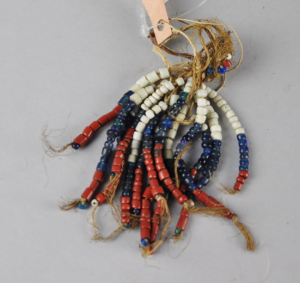That of the attraction of Africans for knick-knacks and objects of little value, accepted in exchange of valuable goods such as precious metals, ivory and enslaved human beings, was a widespread trope in the travelogues of European traders, missionaries and explorers since the fifteenth century. The quintessential objects of this asymmetrical exchange were glass beads, whose purchasing power with the indigenous people of all the newly “discovered” lands soon became legendary. It is quite famous in its exaggeration the legend of the 24 dollars’ worth in beads with which Dutch settlers bought Manhattan from its inhabitants. Another persistent prejudice in Africa – a variation of the latter– was the belief that the value of the beads depended on their widespread use as ornament. The unpredictability of the demand for beads of specific shapes and colors was dismissed by European writers as capriciousness, especially of the women of the groups with which the Europeans had to trade their way to the richesses of the African interior. However, it does not take much attention to find explicit references to glass beads as of a locally employed form of currency, in the same journals.
“Beads as currency”, Kaffa Province, 19th century, Weltmuseum, Wien,
inv. n. 136501- CC BY-NC-SA 4.0 ©KHM-Museumsverband:
https://www.weltmuseumwien.at/object/?detailID=672191
The use of beads as a medium of exchange in Africa is reported by Arabic literature since the fourteenth century, and at least since the fifteenth century a good part of the beads circulating in Africa was produced in the Venetian lagoon. In East Africa, its use was complementary with other mediums of exchange, such as cotton cloth, or cowrie shells. Glass beads were employed especially as smaller denominations, and they were fundamental to buy foodstuff and other supplies for the caravans. As the British explorer Richard Francis Burton illustrated in his travelogue of the expedition to The Lake Region of Central Africa (1860, vol. II, p. 390): “[a]ny neglect in choosing beads, besides causing daily inconvenience, might arrest an expedition on the very threshold of success”. Burton counted over 400 different kinds of beads during his journey, and reported over fifty different names assigned to glass beads of different sizes and shapes. However, using glass beads remained extremely convenient for European traders throughout the nineteenth century, because in the East African interior they could yield a 200 per cent return. This was also due to the low production costs of the glass beads in Venice, where especially female labor remained exploited and underpaid, despite the growing demand for glass beads. Therefore, European traders and explorers had to adapt to local demands and carefully collect information regarding the conditions of markets far from the coast. For this purpose, the knowledge and expertise of caravan leaders returning to the coastal port towns from their travels to the markets of the interior were precious, as much as the speed at which updates reached Europe to adjust the production according to the demand. The need to keep the cost of production low and to constantly adapt the production to African demand for glass beads provides a valid example of the way in which African consumers were involved in the accelerating process of economic integration that laid the foundation of the globalized world.
References
Pallaver, K., ‘From Venice to East Africa: History, Uses, and Meanings of Glass Beads’. In Luxury in Global Perspective. Objects and Practices, 1600-2000., edited by Bernd-Stefan Grewe and Karin Hofmeester, 192–217. New York: Cambridge University Press, 2016.
Pallaver, K., ‘A Recognized Currency in Beads”: Glass Beads as Money in Nineteenth-Century East Africa: The Central Caravan Road’. In Money in Africa, edited by Catherine Eagleton, Harcourt Fuller, and John Perkins, 20–29. London: British Museum Research Publications, 2009.
Trivellato, F., ‘Out of Women’s Hands: Notes on Venetian Glass Beads, Female Labour and International Trades’. In Beads and Bad Makers: Gender, Material Culture, and Meaning, edited by Lidia D. Sciama and Joanne Bubolz Eichez, 47–82. London: Berg, 2020.
Post by Alessandro De Cola


